Daniel Mosquin, University of British Columbia Botanical Garden and Centre for Plant Research, Canada
http://www.ubcbotanicalgarden.org/potd/Abstract
In April 2005, the University of British Columbia Botanical Garden launched its fourth weblog, Botany Photo of the Day. This photograph-driven weblog (“photoblog”) is used to promote and interpret the garden’s collections; educate and advocate on issues of biodiversity, conservation and science literacy; and blend two traditionally disparate concepts - beauty and science. Botany Photo of the Day can be credited with contributing much of the over 100% increase in monthly unique site visitors to the garden’s Web site in a year to year comparison. A number of improvements were made in this iteration of UBC Botanical Garden's experimentation with weblogs, and these techniques and strategies serve as an example that can be used in other institutional weblogs.
Keywords: weblogs, science, user contributions, site promotion, education
Background
In late August 2003, the University of British Columbia Botanical Garden and Centre for Plant Research (UBC BGCPR) launched its first three weblogs:
- UBC Botanical Garden weblog (http://www.ubcbotanicalgarden.org/weblog/), dedicated to “News from the World of Plants”. It features a short article accompanied by links to global plant-related news.
- UBC Botanical Garden and Community News (http://www.ubcbotanicalgarden.org/community/), used to promote garden and local news and events.
- UBC Centre for Plant Research weblog (http://www.ubcbotanicalgarden.org/research/weblog/), targeted to items of interest for the plant researcher community at UBC and area.
All of these are presently in use, and continue to be powered by Movable Type weblogging software (http://www.sixapart.com/movabletype/).
The initial incentive to use weblogging software was to help manage content, i.e., a simple content management system (CMS). For example, each of these three weblogs has a different author responsible for the majority of entries posted, managed through the authoring system that is part of Movable Type’s framework. Weblog entries are categorized, and the resultant RSS (Really Simple Syndication) feeds are used to distribute content throughout the site in appropriate places; e.g., the garden’s main page on plant conservation is supplemented in the right sidebar by links and excerpts to the content in the UBC Botanical Garden weblog categorized “Plant Conservation”.

Fig. 1: The Plant Conservation Page of the UBC Botanical Garden and Centre for Plant Research displaying embedded RSS feed http://www.ubcbotanicalgarden.org/conservation/
Timestamped entries and “future publishing” capabilities allow content to be written in advance and published subsequently, useful for embargoed press releases.
Using the weblogging software as a CMS simplified a number of tasks, but in terms of raising the profile of the garden, could at best be deemed a moderate success (using metrics such as unique site visitors or anecdotal comments). This appears to be due to both the substance and associated promotion of the content on these weblogs. The Garden and Community News and Centre for Plant Research weblogs tend to be institutional and event-driven in nature. The UBC Botanical Garden weblog differs from these two in that it does provide content that may generate discussion. However, the user comment system was removed until mid-2005 due to spam attacks, causing communication to only flow in one direction. Since it was and is a secondary source weblog (i.e., it does not generate a significant amount of original information), it has not been aggressively promoted.
With lessons primarily learned from the UBC Botanical Garden weblog, a different set of strategies and techniques were employed in April of 2005 when UBC BGCPR initiated its fourth weblog, Botany Photo of the Day.
Botany Photo Of The Day
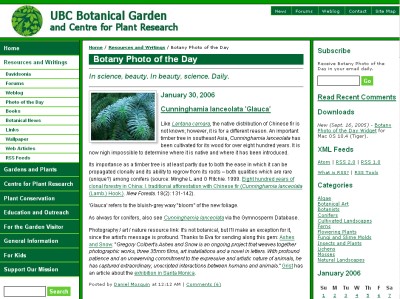
Fig. 2: Botany Photo of the Day main page http://www.ubcbotanicalgarden.org/potd/
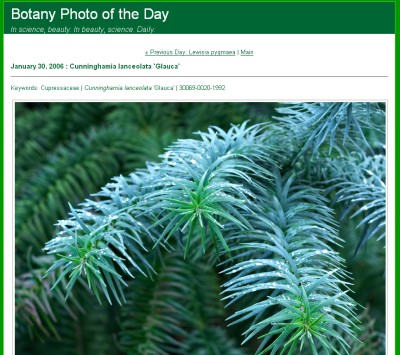
Fig. 3: Botany Photo of the Day example entry page http://www.ubcbotanicalgarden.org/potd/2006/01/cunninghamia_lanceolata_glauca.php
Botany Photo of the Day (BPotD) is a photograph-driven weblog (photoblog) that features a different plant or plant-related image daily with accompanying text. It has a number of goals: to promote and interpret the garden’s collections; to educate and advocate on issues of biodiversity, conservation and science literacy; and to blend two traditionally disparate concepts - beauty and science (its tagline is, “In beauty, science. In science, beauty. Daily”).
The majority of photographs showcase flowering plants, but other categories include natural and cultivated landscapes, conifers, fungi and botanists. During the main gardening season, mid-February to mid-November, roughly two-thirds of the photographs feature accessions from UBC Botanical Garden’s collections. In the other three months, the fraction drops to approximately two in five. Supplementing images of the garden’s collections are reader-contributed photographs, images from researcher and staff field trips, and scans of archival objects (e.g., lantern slides, illustrations) held by the UBC Botanical Garden.
Like the other garden weblogs, Botany Photo of the Day uses Movable Type as its weblogging software. The idea for Botany Photo of the Day was suggested by Tim Bray and Lauren Wood of Sun Microsystems during a technology luncheon with members of the UBC Botanical Garden and Centre for Plant Research staff.
A Different Approach
Botany Photo of the Day employs a set of different strategies and techniques compared to the practices of the garden’s initial three weblogs. These strategies and techniques can be divided into four categories:
- Promotion
- Creating Compelling Content Constantly
- User Contributions
- Enriching and Educating.
Promotion
Participation In Weblog Carnivals
Weblog carnivals are an aggregation of links to recent weblog entries from a number of weblogs built around a particular topic. A blog carnival host accepts submissions from a number of relevant weblogs, and then annotates the collection of links with commentary before publishing it. The host receives traffic from all the participant weblogs (it is considered impolite not to link to the host), while the participant gains exposure by being featured alongside a number of other on-topic weblogs. Two carnivals that have accepted entries from Botany Photo of the Day are Tangled Bank (http://www.tangledbank.net) for science-based writing and Circus of the Spineless (http://invertebrates.blogspot.com), for an entry that featured insects and plants, as Circus of the Spineless is dedicated to invertebrates. Each submission has so far resulted in 50-150 visitor referrals from the hosted weblog carnival. More important, however, are the quality of the links (these are readers guaranteed to be interested in the topic) and the increase in profile with other science-based weblogs.
Submission To Popular Weblogs
The most widely-read weblogs are dedicated to the “big three”: technology, politics and human interest in novelty. Generally, these weblogs accept user submitted stories or items of interest. For museums, botanical gardens and other cultural institutions, the weblogs with an interest in novelty can help promote an event, weblog or exhibit. Chances of success increase if the event, weblog or exhibit somehow caters to the audience of the popular weblog. As an example, on October 17, 2005, a particularly colourful photograph from Botany Photo of the Day was submitted to Boing Boing (http://www.boingboing.net/2005/10/17 /botanist_why_so_much.html). As of January 30, 2006, Boing Boing is ranked as the number one weblog by Technorati (http://www.technorati.com/pop/blogs/) with an emphasis on the quirky and novel. This submission yielded over 700 visitor referrals from the site.
A corollary to the above technique is to identify and work with a weblog “patron” - either a weblogger or widely-read weblog of some renown that has a particular interest in your site, institution or topic and will help promote it. In the case of Botany Photo of the Day, Tim Bray (http://www.tbray.org/ongoing/), Director of Web Technologies at Sun Microsystems, promotes Botany Photo of the Day occasionally. This is unsurprising, perhaps, as he helped generate the idea for the venture in a technology luncheon with garden researchers and staff. However, it also happens that he is personally interested in taking photographs of plants, and discusses his photographs alongside entries about the finer points of XML.
Linking Out
Often institutions develop policies which prohibit linking offsite, with the conservative notion that the content on the external site may change or be substituted. However, the approach taken with Botany Photo of the Day is to link out to quality sites and to do so often. Since UBC Botanical Garden is a small institution, the writing of unique content (or the unique writing of content) is an expensive proposition. Much of what is required to supplement the written content accompanying the daily botanical photograph, however, already exists on-line. A policy of using hyperlinks to other university sites helps provide readers with increased context.
Unlike its other weblog counterparts at the garden, Botany Photo of the Day uses e-mail in two standard ways. Readers can sign up for daily e-mail reminders using a double opt-in permission system and be notified instantly when a new entry is published. Similarly, an e-mail-to-friend ability is offered with each entry to allow users to share particularly compelling photographs with others. Neither of these are groundbreaking techniques, but they are expected by the users. They were not originally offered, but users demanded them.
Web Site Integration
RSS feeds generated from Botany Photo of the Day content allow image thumbnails and excerpts to be distributed on Web pages throughout the site. A recent change to the garden’s site was to create a sidebar alongside the discussion forums. This sidebar features a thumbnailed image of the current Botany Photo of the Day.
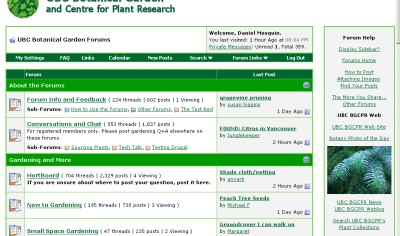
Fig. 4: UBC Botanical Garden discussion forums displaying Botany Photo of the Day image thumbnail in sidebar http://www.ubcbotanicalgarden.org/forums/
The reason? The majority of site visitors to most sites are enticed to visit via a search engine result (a noteworthy exception being those sites which are not indexable by search engine robots). By being fully indexable, the garden’s discussion forums provide over nine thousand pages of content and search strings that might entice a visitor. Promotion of BPotD on these pages supplies casual visitors with a reason to explore the site further and, if they are not familiar with the site, rewards them for having discovered something by serendipity, if they are plant enthusiasts.
Creating Compelling Content Constantly
This phrase is credited to Roland Tanglao (http://www.rolandtanglao.com/archives/2004/07/31/anil_its_not_about_seo_its_about_creating _compelling_content_constantly), a Vancouver area weblogger, who wrote it as a four-word summary argument as to why weblogs achieve high results in search engines. The basis of the argument is that content created on a frequent basis invites search engine robots with a reason to constantly crawl your site. New content on established sites receives a “boost” in some search engine results, so the consistent addition of content ensures near-top rankings temporarily for these entries. The idea has since been broadened as a rationale for attracting not only search engine robots, but site also visitors.
The strategy of constant content offers viewers a reason to incorporate reading a weblog into their day. Several Botany Photo of the Day readers have e-mailed to state that reading the daily entry has become the first thing they check in the morning over coffee.
What about compelling? Compelling is clearly a nod toward human readers as opposed to search engine robots. It’s been an anecdotal observation that people prefer a personal approach on weblogs as opposed to the institutional voice. Despite a subjective approach, it isn’t necessary to be informal; the writing on Botany Photo of the Day still uses a formal style. An- email comment from a reader:
I would like to thank you for your contributions to science and your major contributions to the public understanding of the botanical sciences, I am a retired geologist with an abiding interest in botany. Every day I check your web site … for the Botany Picture of the Day and all the related material. The excellent photos and the chatty and readily understandable descriptions and links to more information have brought me to more interesting botanical information than I can ever assimilate.
In comparison, the objective style attempted by the UBC Botanical Garden weblog communicates an institutional voice and does not invite comment (despite the earlier problems with spam, comments have been restored with updated software).
User Contributions And Creating Content
Cultural institutions and universities have a reputation as being authoritative, and while this has many benefits, it can intimidate and create a barrier to user participation. The use of a personal voice can help people become comfortable with contributing comments which continue to help build the site. It perhaps does not need to be mentioned that the more content available on a site, the more visitors a site will receive. Providing a mechanism for users to contribute allows them to create content for the site, fostering a positive feedback loop.
User Contributions
The title of Botany Photo of the Day is bold. NASA, generator of the Astronomy Picture of the Day, has few peers in its authority on the subject of astronomy. The University of British Columbia Botanical Garden, however, is nowhere near the hub of worldwide botany. In its favour, it does have vascular plant collections from temperate regions around the world. Unfortunately, it is sorely lacking in expertise and exposure to tropical regions containing the lion’s share of diversity of the world’s plants. To be able to represent partially (if not proportionally) the plant biodiversity that exists, user contributions from around the world are a vital and necessary component to BPotD.
To help establish a mechanism for user submissions, a Flickr Group (http://www.flickr.com/groups/botanypotd/) was created. Flickr (http://www.flickr.com) is among the top photo-sharing Web sites in the world, with an extensive international user base. The Flickr Group allows established and new users of Flickr an easy way to add photographs to the pool of potential contributions. The use of Flickr Groups has allowed Botany Photo of the Day to feature plants from Colombia, Ecuador, Israel and India; these are plants which cannot be grown in the temperate climate of Vancouver. Incidentally, the Flickr Group helps to also promote BPotD. When a Flickr user joins a group, the group is listed in their public profile. Other Flickr users visiting a BPotD Flickr Group user’s personal Flickr page can discover Botany Photo of the Day through the list of groups.
In parallel, an established user group of 5000+ participants on the UBC Botanical Garden discussion forums can also submit photographs in a forum dedicated to Botany Photo of the Day submissions.
In addition to photographs, readers of Botany Photo of the Day are encouraged to contribute comments. The commenting system allows people to share their personal stories, add information (such as gardening zones) or correct mistakes made in the entry’s text (which does occur from time to time!). On occasion, the commenting system can generate a long discussion about a particular plant, as happened when people discussed the origin and distribution of strawberry tree in Ireland (http://www.ubcbotanicalgarden.org/potd/2005/12/ arbutus_unedo_f_rubra.php).

Fig 5: Botany Photo of the Day example comments and comment submission form
To set aside concerns of spam and inappropriate use (e.g., posting links to commercially dubious sites), a moderation system is in place; if a commenter is unknown or little known, his or her comment needs to be approved by the weblog administrator. Trusted contributors who have added a number of relevant, thoughtful comments over a small period of time can be whitelisted. They are given the ability to comment without moderation. Commenters subject to moderation are informed when they comment that their comments will be moderated, but also that if they comment frequently, they can be whitelisted. This adds an element of promotion or achievement to those who participate. The introduction of a moderation and whitelist system has allowed communication on Botany Photo of the Day to become two-way, an improvement on the functionality of the initial three weblogs.
A slight twist on user contributions is the occasional submission of a photograph, piece of writing or comment by a UBC Botanical Garden staff member, student or researcher. Accepting contributions has allowed institution-wide participation in the weblog and created a distributed sense of ownership and participation. For researchers, students or curators, BPotD (unlike the other weblogs) gives an opportunity to highlight their research or curatorial area to an audience of several thousand at once.
Enriching and Educating
Understanding and interpretation of collections; informed appreciation of plants; teaching of botanical concepts and practices: these are only a few of the obvious educational benefits of Botany Photo of the Day. However, the enrichment and education goes beyond the subject matter of the primary content.
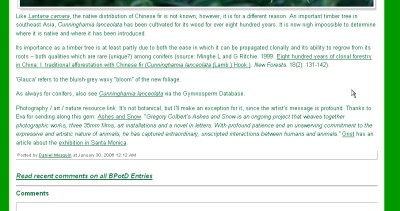
Fig 6: An example of a daily resource link from a Botany Photo of the Day entry
The policy of linking out is extended one step further by providing a daily resource link on a subject of some relevance to readers of BPotD. A significant number of readers are amateur photographers interested in techniques and tips, so resource links alternate between photographic / artistic material and botany / nature / conservation topics. The idea of helping readers better understand the subject material of Botany Photo of the Day is espoused often by Kathy Sierra of the Creating Passionate Users weblog (http://headrush.typepad.com/ creating_passionate_users/). Her philosophy is neatly summarized in her entry, “Kicking Ass is More Fun” (http://headrush.typepad.com/creating_passionate_users/2005 /06/kicking_ass_is_.html):
It's not what you sell, it's what you teach that matters. Or rather, what you help someone learn…[for readers] It's more fun to know more. It's more fun to be able to do more. It's more fun to be able to help others do more.
Lastly, the writing on Botany Photo of the Day is intentionally aimed high, but hopefully not so high as to be incomprehensible; it is meant to challenge people to learn. When possible, references to scientific journals are used to supplement assertions, a strategy to suggest that scientific literacy and the activities of science are not academic, but can be incorporated into an everyday understanding and appreciation of plants and botany.
Metrics
There are a number of metrics to analyze the success of a weblog, though some are not easily quantified. On-line weblog ranking services, social bookmarking sites and Web site visitor statistics provide numeric measures, while weblog comments and reader e-mails generate anecdotal evidence.
On-line Weblog Ranking Services
Technorati (http://www.technorati.com/), a real-time weblog search engine, provides a number of freely available statistics. Two of the most relevant statistics are the number of links from other weblogs to a particular weblog and the number of other weblogs linking to that weblog. For popular weblogs, these are combined to form a Technorati Rank metric. As of January 30, 2006, the numbers for BPotD are 209 links from 101 sites producing a Technorati Rank of 15,963. The UBC Botanical Garden weblog has 100 links from 25 sites, with no calculation of Technorati Rank. On this date, Technorati tracked 26.7 million sites and 1.9 billion links.
Social Bookmarking Sites
Del.icio.us (http://del.icio.us/) provides registered users with the ability to have an on-line repository of bookmarks, allowing people access to their bookmarks from any computer. It goes one step further by providing a social service, so anyone can (if allowed) view other’s bookmarks and see what other people are interested in. The concept is that if one person shares a common interest with someone else, there might be other common interests, and the social bookmarking mechanism allows one person to discover from the interests of others. Additionally, it provides another metric - visitors are allowed to see how many people have bookmarked a site. As of January 30, 2006, BPotD had been bookmarked by 42 people, while the UBC Botanical Garden weblog had been bookmarked by 1. The main garden site had been bookmarked by 5.
Web Site Visitor Statistics
Analyzing Web site visitor statistics can only provide an incomplete picture of the comparative success of Botany Photo of the Day, since the site visitors due to this weblog is embedded within the statistics for the overall site. However, it is impossible to discount the impact of Botany Photo of the Day; since launching, the garden’s Web site has more than doubled its year-over-year unique site visitors (e.g., in April 2004, unique site visitors = 39528 while in April 2005, unique site visitors = 86858).
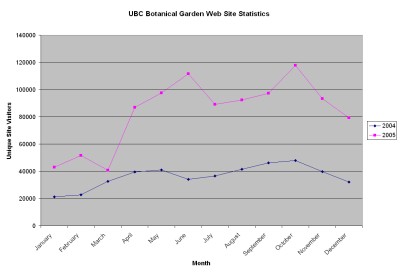
Fig 7: UBC Botanical Garden Web site statistics measuring unique site visitors vs. months for 2004 and 2005. Botany Photo of the Day was launched in April, 2005
Two months, June 2005 and October 2005, have topped 110 000 unique site visitors, whereas the high for unique site visitors prior to launching Botany Photo of the Day was October 2004 with 47885.
Weblog Comments and E-mails
Anecdotal evidence of success with BpotD exists in the weblog comments and reader e-mails. Few, if any, similar comments have been generated by the garden’s other weblogs.
“I just learned that our newest great-granddaughter in Montana has been named Linnea after this beautiful flower.”
“The colors of this flowers are very eye-opening. It is amazing how color can affect the mood of a person, and this photo proves it to be true.”
“I was very happy to read your post. One of the most memorable and striking aspects of the visits I have made to the west (I'm from the eastern US) has been the ponderosa forests--the grand scale of them, the delightful aroma, and the interesting creatures that make their home there. Even after a fire, the burnt trunks retain the cathedral like grandeur. Thanks for providing me with a moment for nostalgia.”
“I love this site, it gives me something to get up for every day. The photos are beautiful, and I get to see some things I never would any other way. Thank you.”
“I just wanted to tell you that your photos are the first things I look for when I sign on in the mornings before work. Your hard work and dedication to this project are certainly appreciated and well loved. Thank you again!”
“Your lovely Web site has gotten better and better! Love the added info you now include (such as the common name). Thanks for being there.”
Conclusion
The success of Botany Photo of the Day compared to other UBC Botanical Garden Web logs can be attributed to promoting the Web log and participating in the weblog community, enabling users to contribute photographs and comments, producing images and original writings that invite conversations and inquiry, and working to help the weblog readers learn more about botany and related topics.
Acknowledgements
The author wishes to acknowledge Tim Bray and Lauren Wood of Sun Microsystems for generating the idea of Botany Photo of the Day. Dr. Quentin Cronk, Director of UBC Botanical Garden and Centre for Plant Research, is acknowledged for his support and vision. The author wishes to thank the staff, researchers and volunteers at UBC Botanical Garden for their contributions and for providing diligent care to much of the subject material seen on Botany Photo of the Day. Finally, the Botany Photo of the Day persists because of the attention, care and contributions of its readers.
References
Boing Boing (2000-). (weblog). Site consulted January 30, 2006. http://www.boingboing.net/
Botany Photo of the Day. (2005-). Site consulted January 30, 2006. http://www.ubcbotanicalgarden.org/potd/.
Bray, T. (2002-). ongoing (weblog). Site consulted January 30, 2006. http://www.tbray.org/ongoing/.
Circus of the Spineless (2005-). Site consulted January 30, 2006. http://invertebrates.blogspot.com/.
Creating Passionate Users (2005). Site consulted January 30, 2006. http://headrush.typepad.com/creating_passionate_users/
Del.icio.us (2003-). Site consulted January 30, 2006. http://del.icio.us/.
Doctorow, C. (2005-). Botanist: why so much colour variation in maple leaves. Last updated 17-Oct-2005 7:05:51 AM. Site consulted January 30, 2006. http://www.boingboing.net/2005/10/17/botanist_why_so_much.html
Flickr (2004-). Site consulted January 30, 2006. http://www.flickr.com/
Flickr Botany Photo of the Day Group (2005). Site consulted January 30, 2006. http://www.flickr.com/groups/botanypotd/.
Mosquin, D. (2006). Cunninghamia lanceolata 'Glauca'. Botany Photo of the Day. Last updated 30-Jan-2006 12:12 AM PST. Site consulted January 30, 2006. http://www.ubcbotanicalgarden.org/potd/2006/01/cunninghamia_lanceolata_glauca.php.
Movable Type (2002). Site consulted January 30, 2006. http://www.sixapart.com/movabletype/.
Tanglao, R. (2004). Anil - it's not about SEO; it's about creating compelling content constantly. Last updated 30-Jul-2004 11:39 PM. Site consulted January 30, 2006. http://www.rolandtanglao.com/archives/2004/07/31/
anil_its_not_about_seo_its_about_creating_compelling_content_constantly.
Sierra, K. (2005). Kicking ass is more fun. Creating Passionate Users weblog. Last updated 6-Jun-2005. Site consulted January 30, 2006. http://headrush.typepad.com/creating_passionate_users/2005/06/kicking_ass_is_.html.
Tangled Bank (2004-). Site consulted January 30, 2006. http://www.tangledbank.net/
Technorati (2003-). Site consulted January 30, 2006. http://www.technorati.com/.
UBC Botanical Garden and Community News. (2003). Site consulted January 30, 2006. http://www.ubcbotanicalgarden.org/community/
UBC Botanical Garden weblog. (2003-). Site consulted January 30, 2006. http://www.ubcbotanicalgarden.org/weblog/
UBC Centre for Plant Research weblog. (2003-). Site consulted January 30, 2006. http://www.ubcbotanicalgarden.org/research/weblog/.
Cite as:
Mosquin D., All Weblogs Are Not Created Equal: Analyzing What Works, in J. Trant and D. Bearman (eds.). Museums and the Web 2006: Proceedings, Toronto: Archives & Museum Informatics, published March 1, 2006 at http://www.archimuse.com/mw2006/papers/mosquin/mosquin.html
